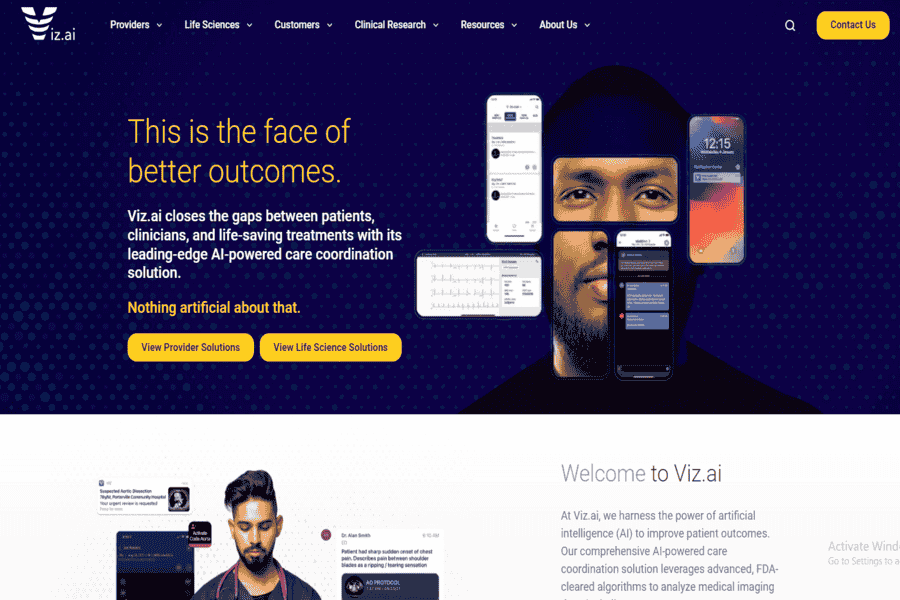Top AI Tools for Medical Imaging and Diagnostics in 2025
December 5, 2024


AI is revolutionizing medical imaging by enhancing accuracy and efficiency. AI tools analyze medical images, detect anomalies, and assist in diagnosis. This paper explores the applications, benefits, and challenges of these tools. By effectively utilizing AI Tools for Medical Imaging and Diagnostics, healthcare providers can improve patient care, reduce diagnostic errors, and accelerate the development of new treatments and therapies. Implementing AI in healthcare requires a robust project management framework to ensure successful integration and optimal patient outcomes.
Accurately identifies and delineates tumors for precise treatment planning.
Isolates specific organs for quantitative analysis and surgical planning.
Automatically detects fractures in X-ray images, aiding in rapid diagnosis.
It improves image quality and reduces radiation dose.
It accelerates image acquisition and enhances image clarity.
Differentiate between diseases, such as cancer types, based on image features.
Identifies unusual patterns that may indicate early-stage diseases.
Assists radiologists in detecting subtle abnormalities.
Reduces human error and enhances diagnostic confidence.
Artificial intelligence (AI) has revolutionized the field of medical imaging, offering a wide range of tools to enhance diagnostic accuracy, streamline workflows, and improve patient outcomes. Here are some of the key types of AI tools used in medical imaging and diagnostics:
AI algorithms can accurately identify and outline tumors in images, aiding in treatment planning and monitoring.
These tools automatically segment specific organs, such as the heart, liver, or lungs, for detailed analysis.
AI can rapidly detect fractures in X-ray images, facilitating timely diagnosis and treatment.
AI algorithms can improve the quality and resolution of CT scans, reducing radiation exposure and enhancing diagnostic information.
These tools can accelerate MRI image acquisition and improve image clarity, making the process more efficient and comfortable for patients.
AI can classify diseases based on image features, such as cancer type or stage, assisting in accurate diagnosis and treatment planning.
These tools can identify unusual image patterns indicating early-stage diseases or abnormalities.
CAD systems can flag potential abnormalities in images, helping radiologists identify subtle findings that might be missed.
CAD systems can increase the sensitivity and specificity of diagnostic tests, leading to more accurate diagnoses and better patient care.
AI algorithms can analyze patient data, including medical images, to predict disease risk and personalize treatment plans.
These tools can help predict how patients respond to specific treatments, allowing for more targeted and effective therapies.
AI can analyze real-time imaging data during surgery, providing precise guidance and improving surgical outcomes.
AI-powered robotic systems can perform complex surgical procedures with greater precision and accuracy than traditional methods.

Aidoc is an AI-powered medical imaging tool designed to assist radiologists in identifying critical conditions such as stroke, pulmonary embolism, and intracranial hemorrhages. It integrates seamlessly with existing workflows to accelerate diagnostic processes and improve patient outcomes.
Pricing is customized based on institution size and required features. Contact Aidoc for a tailored quote.

Zebra Medical Vision uses machine learning to analyze radiological images for various conditions, including osteoporosis, liver disease, and cardiovascular risk. Its AI solutions assist in early disease detection and treatment planning.
Pricing varies; pay-per-scan and subscription-based models are offered.

Arterys is a cloud-based AI platform specializing in medical imaging and analytics for cardiology, oncology, and radiology. It provides automated quantification and reporting tools that reduce diagnostic time and improve accuracy.
Subscription-based pricing tailored to the organization’s needs.

Qure.ai develops AI tools for radiology, including chest X-rays and brain CT scans, improving diagnostic accuracy and accessibility.
Custom pricing based on deployment size and use case.

Infervision focuses on AI-based chest and head CT image analysis to detect early signs of cancer and strokes.
Contact for a tailored quote.

Viz.ai uses AI to streamline stroke diagnosis and care coordination for improved treatment times.
Contact Viz.ai for custom pricing.

Aidence specializes in lung cancer screening through automated analysis of CT scans for early detection.
Pricing is available upon request.

Lunit INSIGHT provides AI-based solutions for detecting chest abnormalities and breast cancer in radiology images.
Custom pricing based on application and scale.
While AI has the potential to revolutionize medical imaging, several significant challenges and limitations need to be addressed:
Obtaining large, diverse, high-quality medical image datasets can be challenging, especially for rare diseases.
Accurate and consistent annotation of medical images is time-consuming and requires expert knowledge.
Strict regulations and ethical considerations govern collecting, storing, and sharing sensitive patient data.
AI models can inadvertently perpetuate biases in training data, leading to discriminatory outcomes for certain patient populations.
Training data may need to adequately represent diverse patient populations, limiting the generalizability of AI models.
Many AI models, particularly deep learning models, are complex and difficult to interpret, making it challenging to understand their decision-making processes.
Healthcare providers need to trust the decisions made by AI systems, which requires transparency and explainability.
Protecting patient privacy and ensuring the security of medical image data is paramount.
AI systems must be used ethically to avoid misuse and potential patient harm.
Determining liability in case of AI-related errors or adverse events is a complex legal and ethical issue.
Despite these challenges, the future of AI in medical imaging is promising, with several exciting trends and innovations on the horizon:
Combining information from multiple modalities, such as imaging, genomics, and clinical data, can provide a more comprehensive understanding of a patient’s condition.
Multimodal learning can improve the accuracy and sensitivity of diagnostic tests.
AI can analyze patient-specific data to identify optimal treatment plans.
By leveraging AI, healthcare providers can deliver more precise and effective treatments.
Real-time analysis of medical images can enable rapid decision-making during procedures.
AI-powered tools can assist surgeons in making accurate and timely decisions.
AI-assisted robotic systems can perform complex surgical procedures with greater accuracy and precision.
AI can enable less invasive surgical techniques, leading to faster recovery and reduced patient discomfort.
The integration of AI tools in medical imaging and diagnostics has ushered in a new era of precision medicine. By leveraging the power of machine learning and deep learning algorithms, AI can significantly improve the accuracy, efficiency, and accessibility of medical imaging. However, addressing the challenges and ethical considerations associated with AI, such as data privacy, bias, and interpretability, is crucial. As AI technology continues to evolve, it is essential to balance innovation and responsible use to ensure patient outcomes. By embracing AI as a valuable tool, healthcare providers can unlock new possibilities and transform how we diagnose and treat diseases.
